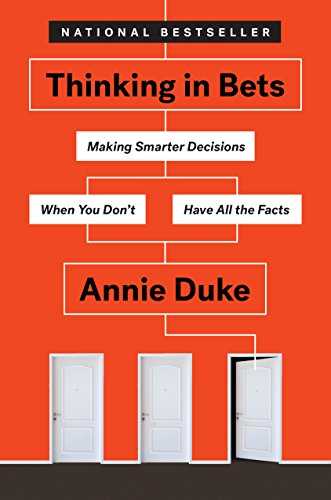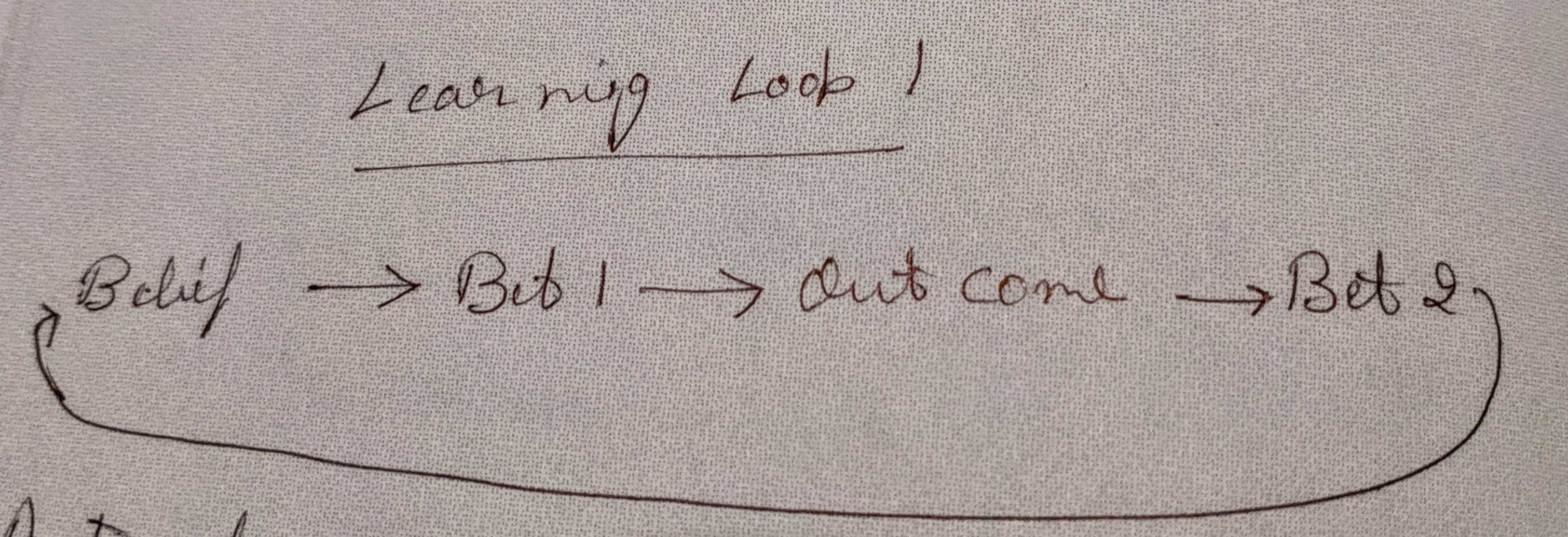Thinking in Bets: Making Smarter Decisions When You Don't Have All the Facts
by: Annie Duke
Check out the book on Amazon | your public library.
43 Highlights | 8 Notes
Over time, those world-class Poke players taught me to understand what a bet really is: a decision about an uncertain future.
Thinking in bets starts with recognizing that there are exactly two things that determine how our lives turn out: the quality of our decisions and luck. Learning to recognize the difference between the two is what thinking in bets is all about.
Peter Carroll was a victim of our tendency to equate the quality of a decision with the quality of its outcome. Poker players have a word for this: 'resulting'.
Hindsight bias is the tendency, after an outcome is known, to see the outcome as having been inevitable.
We recognize the existence of luck, but we resist the idea that, despite our best efforts, things might not work out the way we want.
In addition, once the game is over, poker players must learn from that jumbled mass of outcomes and decisions, separating the luck from the skills, the signal from the noise, and guarding against resulting.
We all struggle to execute our best intentions.
Poker, in contrast (to chess), is a game of incomplete information. It is a game of decision-making under conditions of uncertainty over time. (Not coincidentally, that is close to the definition of game theory.) Valuable information stays hidden. There is also an element of luck in any outcome. You could make the best possible decision at every point, and still lose the had, because you don't know what new cards will be dealt and revealed.
They understand that they can almost never know exactly how something will turn out. They embrace the uncertaintly and, instead of focusing on being sure, they try to figure out how unsure they are, making their best guess at the chances that different outcomes will occur.
Decisions are bets on the future, and they aren't 'right' or 'wrong' based on whether they turn out well on any particular iteration.
Whenever we make a choice, we are betting on a potential future. We are betting that the future version of us that results from the decitions we make will be better off.
Part of the skill in life comes from learning to be a better belief calibrator, using experience and information to more objectively update our beliefs to more accurately represent the world. The more accurate our beliefs, the better the foundation of the bets we make. There is also skill in identifying when our thinking patterns might lead us astray, no matter what our beliefs are, and in developing strategies to work with (and sometimes around) those thinking patterns.
This is how we think we form abstract beliefs:
- We hear something;
- We think about it and vet it, determining whether it is true or false; only after that
- We form our belief.
- We hear something
- We believe it to be true
- Only sometimes, later, if we have the time or inclination, we think about it and vet it, determining whether it is, in fact, true or false.
Once a belief is lodged, it becomes difficult to dislodge. It takes on a life of its own, leading us to notice and seek out evidence confirming our belief, rarely challenge the validity of confirming evidence, and ignore or work hard to actively discredit information contradicting the belief. This irrational, circular information-processing pattern is called motivated reasoning.
We would be better served as communicators and decision makers if we thought less abouth whether we are confident in our beliefs and more about how confident we are.
Living in the matrix is comfortable. So is the natural way we process information to protect our self-image in the moment. By choosing to exit the matrix, we are asserting that striving for a more objective representation of the world, even if it is uncomfortable at times, will make use happier and more successful in the long run.
Forming or joining a group where the focus is on thinking in bets means modifying the usual social contract. It means agreeing to be open-minded to those who disagree with us, giving credit where its due, and taking responsibility where it's appropriate, even (and especially) when it makes us uncomfortable.
We win bets by relentlessly striving to calibrate our beliefs and predictions about the future to more accurately represent the world.
I got my fix by trying to be the best credit-giver, the best mistake admitter, and the best finder-of-mistakes in good outcomes.
Early in my poker career, my poker group recommended that a way to avoid the effects of self-serving bias when I was losing was to have a preset 'loss limit' - if I lost $600 at the stakes I was playing, I would leave the game.
When we think in bets, we run through a series of questions to examine the accuracy of our beliefs. For example,
- Why might my belief not be true?
- What other evidence might be out there bearing on my belief>
- Are there similar areas I can look toward to guage whether similar beliefs to mine are true?
- What sources of information could I have missed or minimized on the way to reaching my belief?
- What are the reasons someone else could have a different belief, what's their support, and why might they be right instead of me?
- What other perspectives are there as to why things turned out the way they did?
CUDOS
- Communism (data belongs to the group)
- Universalism (apply uniform standards to claims and evidence, regardless of where they come from)
- Disinterestedness (vigilance against potential conflicts that can influence the group's evaluation)
- Organized Skepticism (discussion among group to encourage engagement and dissent)
If a group is bling to the outcome, it produces higher fidelity evaluation of decision quality.
…
To address this, many expert Poker players often omit the outcome when seeking advice about their play.
…
To address this, many expert Poker players often omit the outcome when seeking advice about their play.
Skepticism is about approachind the world by asking why things might not be true rather than why they are true. It's a recognition that, while there is an objective truth, everything we belive about the world is not true. Thinking in bets embodies skepticism by encouraging us to examine what we do and don't know, and what our level of confidence is in our beliefs and predictions.
For example, listen for the things you agree with, state those and be specific, and then follow then with 'and' instead of 'but'.
This tendency we all have to favor our present-self at the expense of our future-self is called temporal discontinuity.
But if regret occured before a decision instead of after, the experience of regret might get us to change a choice likely to result in a bad outcome.
The way we field outcomes is path dependent. It doesn't so much matter where we end up as how we got there.
Because poker players are in a constant struggle to keep in-the-moment fluctuations in perspective, their jargon has a variety of terms for the concept that “bad outcomes can have an impact on your emotions that compromise your decision-making going forward so that you make emotionally charged, irrational decisions that are likely to result in more bad outcomes that will negatively impact your decision-making going forward and so on.” The most common is tilt
If you blow some recent event out of proportion and react in a drastic way, you're on tilt.
By recognizing in advance these verbal and psychological signs that ticker watching is making us tilt, we can commit to develop certain habit routines at those moment. We can precommit to walk away from the situation when we feel the signs of tilt, whether it's a fight with a spouse or child, aggravation in a work situation, or losing at a poker table. We can take some space till we calm down and get some perspective, recognizing that when we're on tilt, we aren't decision fit
For us to make better decisions, we need to perform reconnaisance on the future. If a decision is a bet on a particular future based on our beliefs, then before we place a bet, we should consider in detail what those possible futures might look like. Any decision can result in a set of possible outcomes.
Figure out the possibilities, then take a stab at the probabilities. To start, we imagine the range of potential futures. This is also known as scenario planning.
After identifying as many of the possible outcomes as we can, we want to make our best guess at the probability of each of those futures occuring.
Turns out, if we were contemplating a thousand-mile walk, we'd be better off imagining ourselves looking back from the destination and figuring how we got there. When it comes to advance thinking, standing at the end and looking backward is much more effective than looking forward from the beginning.
A premortem is where we check our positive attitude at the door and imagine not achieving our goals.
Backcasting and premortems complement each other. Backcasting imagines a positive future; a premortem imagines a negative future. We can't create a complete picture without representing both the positive and negative space. Backcasting reveals the positive space. Premortems reveal the negative space. Backcasting is the cheerleader; a premortem is the heckler in the audience.
We start a premortem by imagining why we failed to reach our goal; our company hasn't increased its marketshare; we didn't lose weight; the jury verdict came back for the other side; we didn't hit our sales target. Then we imagine why. All those reasons why we didn't achieve our goal help us anticipate potential obstacles and improve our likelihood of succeeding.
Once we frame our exercise as “Okay, we failed. Why did we fail?” that frees everyone to identify potential points of failure they otherwise might not see or might not bring up for fear of being viewed as a naysayer.

